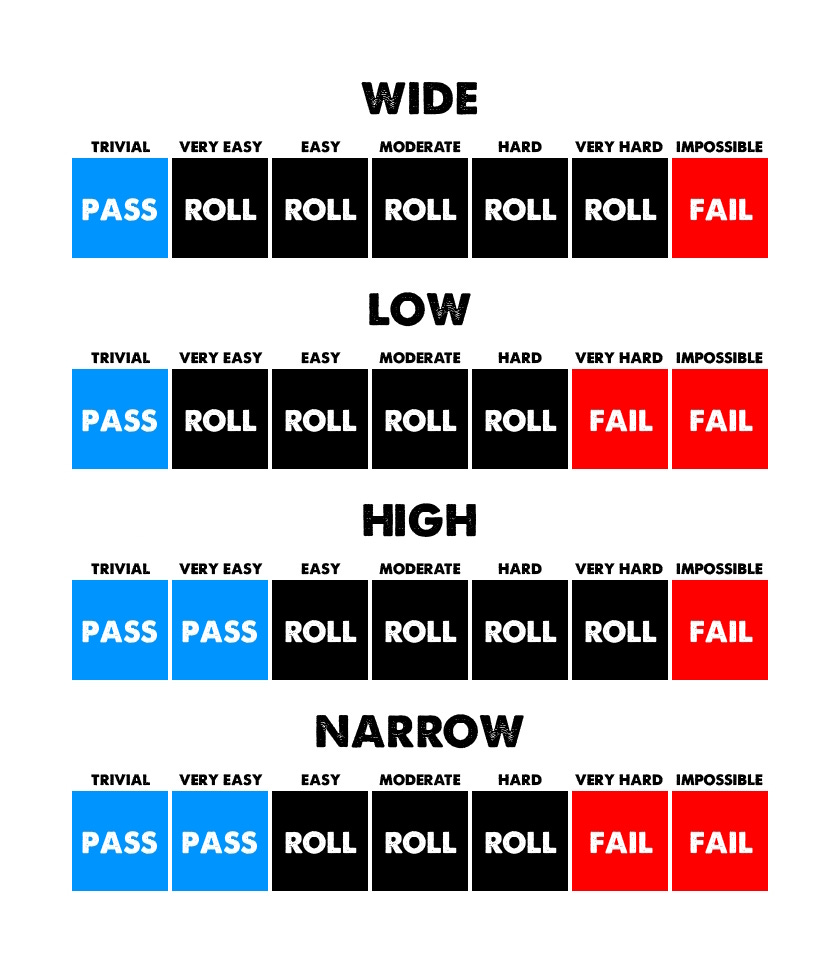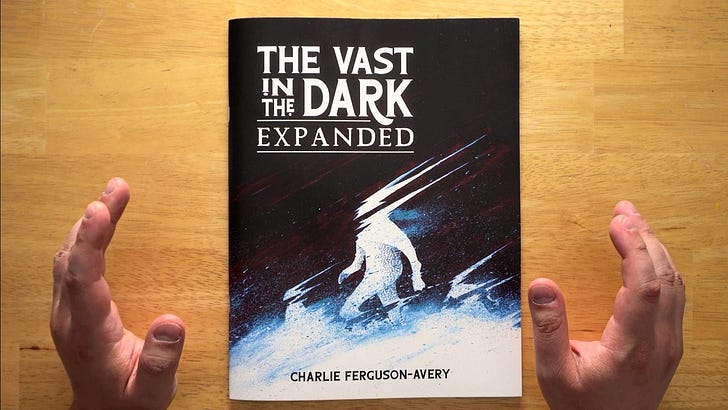This week’s review is of Scrap’s new monster art book Malustrious Brood. Includes a look at one of Scrap’s sculptures!
The secret newsletter-only sale for Summer’s End continues. Drop a dungeon or an adventure hex into your campaign at a moment’s notice!
This bonus post is free for all subscribers. Don’t forget to check out the poll at the end!
Three months ago I ran a poll over at Questing Beast (3,700+ responses) looking how GMs actually handle when to roll, and it turns out some approaches are much more popular than others.
I’ve given each approach a name: Wide, Low, High, and Narrow. The names come from the fact that each of them creates a different “roll window” within which it’s permissible for the GM to call for a roll rather than just declaring the result. It’s easiest to see this by looking at the visualization below.
Wide Roll Window: “There’s Always a Chance.”
Popularity: 19%
Roll frequency: High. Only forgo rolling when the task is completely trivial or utterly impossible.
Motivation: Fairness and a desire to simulate the world.
Upsides:
The chance of success or failure might be extremely small, but those rare outcomes might make the game more memorable.
Great for groups that love engaging with the game mechanics and optimizing their characters.
Downsides:
All of the rolling takes up time and can make the game feel like it’s governed more by chance than by the players’ choices.
Players might focus on their character sheet more than the situation at hand.
Low Roll Window: “Prepare to Die.”
Popularity: 12%
Roll frequency: Moderate. Very easy tasks require a roll to succeed, but very hard tasks automatically fail.
Motivation: Tension, fear.
Upsides:
This probably works best for horror or grimdark games where you want things to always be getting worse and for the players to really struggle to succeed.
Good for players who enjoy “hardcore mode.”
Downsides:
The players may not like having the odds tipped against them and might perceive the GM to be antagonistic.
Requires strong group buy-in.
High Roll Window: “You are the Chosen One.”
Popularity: 55%
Roll frequency: Moderate. Very easy tasks automatically succeed and you are allowed a roll in very hard situations.
Motivation: Power, forward momentum.
Upsides:
Most players enjoy the game being tipped in their favor, making this by far the most popular window and what most consider to be “good GMing.”
Auto-passing very easy rolls keeps things moving quickly, and allowing rolls for very hard tasks makes players feel like anything is possible.
Works well for the heroic or action genres.
Downsides:
Allowing the players to roll their way out of very hard situations makes it harder to evoke real danger. Rather than treating threats seriously, players may depend on their character’s stats to save them.
It may push players towards acting rather than thinking. If high rolls can always win the day, then there’s less incentive to negotiate, prepare, or avoid confrontation altogether.
Players might feel that this approach makes their victories feel less earned.
Narrow Roll Window: “Think Your Way Out.”
Popularity: 14%
Roll frequency: Low. Very easy tasks automatically succeed and very hard tasks automatically fail.
Motivation: In-world problem solving, prioritizing player skill over character skill.
Upsides:
The least amount of rolling, so the game moves the fastest.
Rolling is often used as a way to abstract away the player’s engagement with the world. Shrinking the roll window encourages interaction and gives players a greater sense of control over their characters.
If very hard tasks automatically fail, you get less “Hail Mary” play, where players ask to roll for highly implausible actions to see if they work. You can just tell them that the attempt would fail and move on. This window imposes more limits on players’ actions, but limitations breed creativity.
It’s the window that incentivizes thinking the most. If very easy tasks automatically succeed, that pushes players to try to come up with smart plans that reduce or eliminate risk. When players want to try something very hard you can say, “That’s going to automatically fail unless you have a solid plan. And if your plan is good enough, it’ll just work.”
Downsides:
The game feels less “realistic” since you aren’t getting to roll for that 1% chance of success that Moldvay recommends.
It relies more on GM fiat than other windows, because the GM makes more calls on what counts as “very easy” and “very hard”, which some people won’t like. It’s a high-trust style that requires buy-in.
And that’s the real question, isn’t it? What counts as “very easy” and “very hard”? I think a task is in those categories when it’s right on the borderline. When I’m pretty sure what the result is going to be, but maybe a roll would make sense…that’s when I just declare the results.
As you might expect, the narrow window is the one I like the best, but the high window can also be fun.
Next time: I’ll look at another way to reduce rolling and give the players more agency. In the meantime, check out the poll below.
Posts You May Have Missed:
What RPGs can learn from board games
Previously, I mentioned how RPG players seem to be willing to put up with gameplay that would be anathema in a board game. Let’s expand on that.
Mechanics that RPGs don't use
After decades of development, boardgame mechanics have ended up exploring a huge swath of game design space, much of which hasn’t been used in RPGs. But what if it was?






Solid article, but I disagree with your framing of the high roll window. I would describe my DMing style as using the high roll window, but not for power fantasy forward momentum purposes.
Easier checks are typically going to be a larger proportion of all checks, so raising the floor on what low risk checks are made significantly reduces the amount of unnecessary checks at the table.
I definitely follow a ‘think your way out’ OSR style of DMing, however I do see value in allowing very rare Hail Mary checks, but for players those should be treated as a fail state. For the highest stakes moments at my table the assumption is that the odds of that roll will be weighted against them, so they are always looking for how to outsmart the problem in a way that lets them avoid having to roll. When I let them roll in those “very hard” circumstances it’s not just a roll for success, it’s that they have an idea for how to get through the problem but they haven’t been able to remove all of the risk.
Put simply, the high roll window is not just about power play, it can be about streamlining play while allowing high tension moments to come down to a dice roll once in a while.
Oh wide window all the way. Obey the dice.